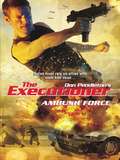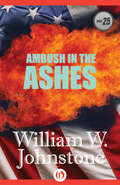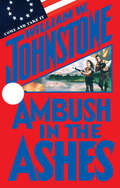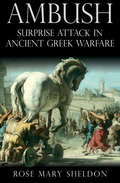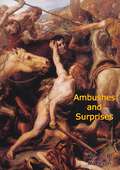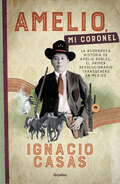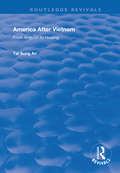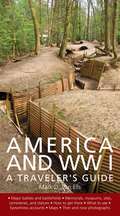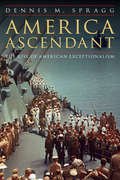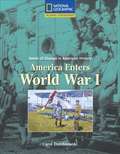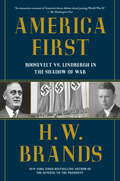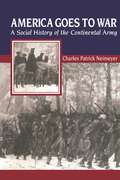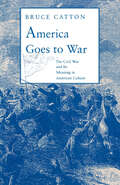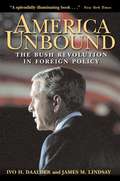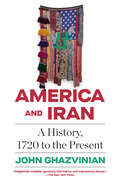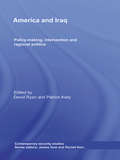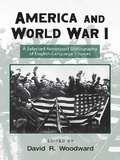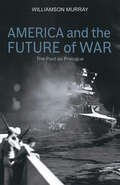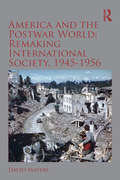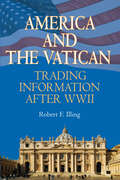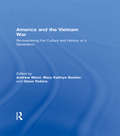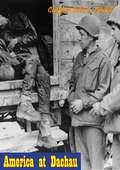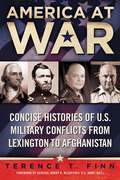- Table View
- List View
Ambush Force
by Don PendletonDeep CoverWhen an elite branch of U. S. Army Rangers are beheaded and burned in Afghanistan, fingers point to the Taliban. But Mack Bolan suspects otherwise. He's betting it was an inside job. But why? And, more importantly, whose hands are covered in Ranger blood?Looking for answers--and payback--Bolan goes undercover with a private security company based in Afghanistan. Immersed in the cutthroat world of hired assassins and a carefully hidden plot to offer up mercenaries and liberators alike to the highest bidder, Bolan finds himself in deeper than ever before. The Executioner will need to work fast--before he becomes the next casualty.
Ambush In the Ashes (Ashes #25)
by William W. JohnstoneIn the ashes of the apocalypse, Ben Raines and his Rebels face a new obstacle: the anarchists and barbarians who seek to destroy what's left of the Red, White and Blue. But their depraved ideology isn't restricted to the new America. They're contaminating the whole damn world... From Morocco, Algeria, Libya, and Egypt, Ben Raines' fearless battalions are positioned to advance. The destination: Southern Africa. Their mission: free it from the domination of Bruno Bottger and his neo-Nazi armies. The seasoned SS combat stompers are on the verge of turning Hitler's nightmare into a new reality. But that means taking on Raines and his Rebels first. And no one has ever tried, has ever survived...
Ambush in the Ashes (Ashes #25)
by William W. JohnstoneA rebel patriot force goes to battle against a resurgent Nazi army in Africa in this post-apocalyptic adventure by the New York Times bestselling author. After a nuclear strike decimates America, retired soldier Ben Raines refuses to let his once great nation be snuffed out. In the ashes of the apocalypse, he and his Rebels face off against the anarchists and barbarians who seek to destroy what's left of the Red, White and Blue. But the threat to civilization knows no borders. Now, Raines's battalions are positioned to advance on Southern Africa in pursuit of Bruno Bottger and his neo-Nazi armies. Those seasoned SS combat stompers are on the verge of turning Hitler's nightmare into a new and terrible reality—unless Raines wipes them out first.
Ambush: Surprise Attack in Ancient Greek Warfare
by Rose Mary SheldonThere are two images of warfare that dominate Greek history. The better known is that of Achilles, the Homeric hero skilled in face-to-face combat to the death. He is a warrior who is outraged by deception on the battlefield. The alternative model, equally Greek and also taken from Homeric epic, is Odysseus, the man of twists and turns of The Odyssey. To him, winning by stealth, surprise or deceit was acceptable.Greek warfare actually consists of many varieties of fighting. It is common for popular writers to assume that the hoplite phalanx was the only mode of warfare used by the Greeks. The fact is, however, that the use of spies, intelligence gathering, ambush, and surprise attacks at dawn or at night were also a part of Greek warfare, and while not the supreme method of defeating an enemy, such tactics always found their place in warfare when the opportunity or the correct terrain or opportunity presented itself.Ambush will dispel both the modern and ancient prejudices against irregular warfare and provides a fresh look at the tactics of the ancient Greeks.
Ambushes and Surprises
by Col. G. B. MallesonAmbushes and surprise attacks are tactics as old as warfare itself. This instructive and interesting book, written by a distinguished Victorian soldier and military historian, describes and analyses some of history’s most famous military ambushes—including Hannibal’s waylaying of the Romans on the shores of Lake Trasimene; the other great disaster to Roman arms when the Legions were lured to their doom by the Teutonic tribes of Germanicus in the Teutoburg Forest; from the Age of Charlemagne Malleson tells the story of Roland and Oliver’s doomed stand against the Moors at Roncesvalles in the Pyrenees. Other surprises and ambushes recounted in the book include Marshal Massena’s campaign of 1799 around the St Gothard Pass in the Swiss Alps, and France’s successful ambush of Braddock’s British force in the North American wilderness at Fort Duquesne. Each account is illustrated by a map, making this a most illuminating as well as an highly entertaining, read.-Print ed.
Amelio, mi coronel: La asombrosa historia de Amelio Robles, el primer revolucionario tránsgenero en México
by Ignacio CasasBASADA EN HECHOS REALES, AMELIO, MI CORONEL RESCATA DEL OLVIDO A UNO DE LOS PERSONAJES MÁS APASIONANTES Y SINGULARES DE LA REVOLUCIÓN MEXICANA, QUIEN CON REBELDÍA ROMPIÓ LOS MOLDES DE LA ÉPOCA. UNA NOVELA QUE NOS RECUERDA QUE EL DESTINO SE FORJA, AUNQUE SEA A BALAZOS. A los veintiún años, con enaguas y rebozo, Malaquías Amelia de Jesús se unió al Ejército Libertador del Sur, en compañía de la Casimira, la pistola de su amado y difunto padre, y de ese espíritu voluntarioso que tanto le caracterizó. Fue ahí, en el campo de batalla, entre muertes y desplazamientos, pero también entre amores y victorias, donde encontró la fuerza para gritar su nombre: ¡Ameno! Admirado y respetado por generales, capitanes e incluso por la tropa, Amelio Robles luchó junto a notables revolucionarios: Chon Díaz, Heliodoro Castillo, Adrián Castrejón y, por supuesto, Emiliano Zapata. Ya como coronel, dirigió más de quinientos soldados, luchando contra el enemigo, así como contra aquellos que cuestionaban su identidad. Escrita con maestría y ritmo poético por el ganador del Premio de Novela Histórica Grijalbo-Claustro de Sor Juana 2019, Ignacio Casas, Amelio, mi coronel es una obra repleta de pasajes emocionantes, un homenaje a la vida que uno elige.
America After Vietnam: From Anguish to Healing (Routledge Revivals)
by Tai Sung AnFirst published in 1997, this volume explores the twenty years it has taken the United States to decide where Vietnam belongs on its mental landscape, as indicated by the establishment of official diplomatic relations between the two countries on August 5, 1995. Having won the Cold War, but lost a skirmish in Vietnam, America’s defeat can now be set in context against subsequent campaigns in Afghanistan, Angola, El Salvador, Eritrea, Nicaragua, Somalia, Sudan and elsewhere which suggest that the best any outsider can expect by intervening in Third World domestic conflicts is a hugely expensive, bloody stalemate. Tai Sung-An identifies that, despite America’s painful, deep and very expensive involvement in Vietnam for a lengthy two decades, Americans fought, failed and left while remaining ignorant of the most elementary knowledge of Vietnam, symptomatic of a cultural gap, isolationism and even intellectual complacency.
America And Wwi: A Traveler's Guide
by Mark D. Van EllsFOLLOWING THE DOUGHBOY FROM THE HOME FRONT TO THE WESTERN FRONT--AND MAPPING THE MANY MEMORIALS BUILT IN HIS HONOR
America Ascendant: The Rise of American Exceptionalism
by Dennis M. SpraggAmerica Ascendant vividly portrays the global crisis that brought the media and the government into an alliance that changed the course of American and world history. President Franklin D. Roosevelt organized an extraordinary partnership between the U.S. government and America&’s media outlets to communicate to the reluctant and isolationist American public the nature of the threat that World War II posed to the nation and the world. The coalition&’s aim was to promote the concept of American exceptionalism and use it to galvanize the public for the government&’s cause.America Ascendant details the efforts of many prominent individuals and officials to harness the collective energy of the nation and guide the United States throughout World War II then describes its aftermath and the Cold War period. Dennis M. Spragg demonstrates how the news and entertainment of American broadcasters such as David Sarnoff, William Paley, and Elmer Davis helped rally the American people to fashion a new liberal democratic order to stop the global spread of Communism. This media-government alliance, however, was not achieved without difficulty. Spragg highlights the competing visions and personalities that clashed, as media and government leaders tried to develop the paradigm that ultimately shifted American cultural and political thought. Throughout this searching history he sheds light on the underappreciated coordination between the media and the government to establish a liberal democratic world order and demonstrates why American exceptionalism still matters.
America Enters World War I
by Carol DomblewskiThe book talks about the World War I's two main alliances,how nations began to build strong armies,navies, to train soldiers , make weapons and how America entered the war.
America First: Roosevelt vs. Lindbergh in the Shadow of War
by H. W. BrandsBestselling historian and Pulitzer Prize finalist H. W. Brands narrates the fierce debate over America's role in the world in the runup to World War II through its two most important figures: President Franklin D. Roosevelt, who advocated intervention, and his isolationist nemesis, aviator and popular hero Charles Lindbergh.&“An immersive account of America&’s fierce debate about joining World War II.&” — The Washington Post"Brands&’s elegant account of the political faceoff between Franklin Roosevelt and Charles Lindbergh could not be more timely." — Charles A. Kupchan, author of Isolationism: A History of America&’s Efforts to Shield Itself from the WorldHitler's invasion of Poland in September 1939 launched a momentous period of decision-making for the United States. With fascism rampant abroad, should America take responsibility for its defeat?For popular hero Charles Lindbergh, saying no to another world war only twenty years after the first was the obvious answer. Lindbergh had become famous and adored around the world after his historic first flight over the Atlantic in 1927. In the years since, he had emerged as a vocal critic of American involvement overseas, rallying Americans against foreign war as the leading spokesman the America First Committee. While Hitler advanced across Europe and threatened the British Isles, President Franklin Delano Roosevelt struggled to turn the tide of public opinion. With great effort, political shrewdness and outright deception—aided by secret British disinformation efforts in America—FDR readied the country for war. He pushed the US onto the world stage where it has stayed ever since.In this gripping narrative, H.W. Brands sheds light on a crucial tipping point in American history and depicts the making of a legendary president.
America Goes to War: A Social History of the Continental Army (The American Social Experience #26)
by Charles Patrick NeimeyerA unique and revealing analysis of the diverse body that made up the Continental Army during the American Revolutionary War.One of the images Americans hold most dear is that of the drum-beating, fire-eating Yankee Doodle Dandy rebel, overpowering his British adversaries through sheer grit and determination. The myth of the classless, independence-minded farmer or hard-working artisan-turned-soldier is deeply ingrained in the national psyche.Charles Neimeyer here separates fact from fiction, revealing for the first time who really served in the army during the Revolution and why. His conclusions are startling. Because the army relied primarily on those not connected to the new American aristocracy, the African Americans, Irish, Germans, Native Americans, laborers-for-hire, and “free white men on the move” who served in the army were only rarely altruistic patriots driven by a vision of liberty and national unity.Bringing to light the true composition of the enlisted ranks, the relationships of African-Americans and of Native Americans to the army, and numerous acts of mutiny, desertion, and resistance against officers and government, Charles Patrick Neimeyer here provides the first comprehensive and historically accurate portrait of the Continental soldier.
America Goes to War: The Civil War and Its Meaning in American Culture
by Bruce CattonA fascinating study of the first modern war and its effect on American Culture.
America Invulnerable: The Quest for Absolute Security from 1812 to Star Wars
by James Chace Caleb CarrSurvey of our foreign policy through the 1980's.
America Unbound: The Bush Revolution in Foreign Policy
by Ivo H. Daalder James M. LindsayAnalysis of George W. Bush's foreign policy, specifically from the start of his administration to mid 2003.
America and Iran: A History, 1720 to the Present
by John GhazvinianAn important, urgently needed book--a hugely ambitious, illuminating portrait of the two-centuries-long entwined histories of Iran and America, and the first book to examine, in all its aspects, the rich and fraught relations between these two powers--once allies, now adversaries. By an admired historian and the author of Untapped: The Scramble for Africa's Oil ("he would do Graham Greene proud"--Kirkus Reviews).In this rich, fascinating history, John Ghazvinian traces the complex story of the relations of these two powers back to the Persian Empire of the eighteenth century--the subject of great admiration of Thomas Jefferson and John Quincy Adams--and an America seen by Iranians as an ideal to emulate for their own government.Drawing on years of archival research both in the United States and Iran--including access to Iranian government archives rarely available to Western scholars--the Iranian-born, Oxford-educated historian leads us through the four seasons of U.S.-Iran relations: the "spring" of mutual fascination; the "summer" of early interactions; the "autumn" of close strategic ties; and the long, dark "winter" of mutual hatred.Ghazvinian, with grasp and a storyteller's ability, makes clear where, how, and when it all went wrong. And shows why two countries that once had such heartfelt admiration for each other became such committed enemies; showing us, as well, how it didn't have to turn out this way.
America and Iraq: Policy-making, Intervention and Regional Politics (Contemporary Security Studies)
by David Ryan Patrick KielyThis edited volume provides an overview on US involvement in Iraq from the 1958 Iraqi coup to the present-day, offering a deeper context to the current conflict. Using a range of innovative methods to interrogate US foreign policy, ideology and culture, the book provides a broad set of reflections on past, present and future implications of US-Iraqi relations, and especially the strategic implications for US policy-making. In doing so, it examines several key aspects of relationship such as: the 1958 Iraqi Revolution; the impact of the 1967 Arab-Israeli War; the impact of the Nixon Doctrine on the regional balance of power; US attempts at rapprochement during the 1980s; the 1990-91 Gulf War; and, finally, sanctions and inspections. Analysis of the contemporary Iraq crisis sets US plans against the ‘reality’ they faced in the country, and explores both attempts to bring security to Iraq, and the implications of failure.
America and Vietnam: The Elephant and the Tiger
by Albert MarrinExamines the political history, military events, social impact, and long-term effects of the Vietnam War.
America and World War I: A Selected Annotated Bibliography of English-Language Sources (Routledge Research Guides to American Military Studies)
by David WoodwardAmerica and World War I, the first volume in the new Routledge Research Guides to American Military Studies series, provides a concise, annotated guide to the vast amount of resources available on the Great War. With over 2,000 entries selected from a wide variety of publications, manuscript collections, databases, and online resources, this volume will be an invaluable research tool for students, scholars, and military history buffs alike. The wide range of topics covered include war films and literature, to civil-military relations, to women and war. Routledge Research Guides to American Military Studies will include concise, easy-to-use bibliographic volumes on different American military campaigns throughout history, as well as tackling timely subjects such as women in the military and terrorism.
America and the Future of War: The Past as Prologue
by Williamson MurrayThroughout the world today there are obvious trouble spots that have the potential to explode into serious conflicts at any time in the immediate or distant future. This study examines what history suggests about the future possibilities and characteristics of war and the place that thinking about conflict deserves in the formation of American strategy in coming decades. The author offers a historical perspective to show that armed conflict between organized political groups has been mankind's constant companion and that America must remain prepared to use its military power to deal with an unstable, uncertain, and fractious world.Williamson Murray shows that while there are aspects of human conflict that will not change no matter what advances in technology or computing power may occur, the character of war appears to be changing at an increasingly rapid pace with scientific advances providing new and more complex weapons, means of production, communications, and sensors, and myriad other inventions, all capable of altering the character of the battle space in unexpected fashions. He explains why the past is crucial to understanding many of the possibilities that lie in wait, as well as for any examination of the course of American strategy and military performance in the future—and warns that the moral and human results of the failure of American politicians and military leaders to recognize the implications of the past are already apparent.
America and the Postwar World: Remaking International Society, 1945-1956 (Routledge Studies in Modern History)
by David MayersThe main tide of international relations scholarship on the first years after World War II sweeps toward Cold War accounts. These have emphasized the United States and USSR in a context of geopolitical rivalry, with concomitant attention upon the bristling security state. Historians have also extensively analyzed the creation of an economic order (Bretton Woods), mainly designed by Americans and tailored to their interests, but resisted by peoples residing outside of North America, Western Europe, and Japan. This scholarship, centered on the Cold War as vortex and a reconfigured world economy, is rife with contending schools of interpretation and, bolstered by troves of declassified archival documents, will support investigations and writing into the future. By contrast, this book examines a past that ran concurrent with the Cold War and interacted with it, but which usefully can also be read as separable: Washington in the first years after World War II, and in response to that conflagration, sought to redesign international society. That society was then, and remains, an admittedly amorphous thing. Yet it has always had a tangible aspect, drawing self-regarding states into occasional cooperation, mediated by treaties, laws, norms, diplomatic customs, and transnational institutions. The U.S.-led attempt during the first postwar years to salvage international society focused on the United Nations Relief and Rehabilitation Administration, the Acheson–Lilienthal plan to contain the atomic arms race, the Nuremberg and Tokyo tribunals to force Axis leaders to account, the 1948 Genocide Convention, the 1948 Universal Declaration of Human Rights, and the founding of the United Nations. None of these initiatives was transformative, not individually or collectively. Yet they had an ameliorative effect, traces of which have touched the twenty-first century—in struggles to curb the proliferation of nuclear weapons, bring war criminals to justice, create laws supportive of human rights, and maintain an aspirational United Nations, still striving to retain meaningfulness amid world hazards. Together these partially realized innovations and frameworks constitute, if nothing else, a point of moral reference, much needed as the border between war and peace has become blurred and the consequences of a return to unrestraint must be harrowing.
America and the Vatican: Trading Information after World War II
by Robert F. IllingThe reader is given a rare view of the operations of the Vatican in the diplomatic world and some fascinating sidelights into the Vatican archives such as the role Benjamin Franklin played in the selection of the first Catholic Bishop in the United States and what the Pope actually intended to do about Henry the VIII. Robert Illing brings the reader into the fascinating and colorful political world of the Vatican, a unique entity with the dual nature of political state which functions apart from its other position as center of the Roman Catholic Church. A separate politcal state with diplomatic offices in most countries in the world, the Vatican has a unique position as a listening post unlike any other country in the world. Robert Illing brings the reader into that fascinating world.
America and the Vietnam War: Re-examining the Culture and History of a Generation
by Andrew Wiest Mary Kathryn Barbier Glenn RobinsThe Vietnam War was one of the most heavily documented conflicts of the twentieth century. Although the events themselves recede further into history every year, the political and cultural changes the war brought about continue to resonate, even as a new generation of Americans grapples with its own divisive conflict. America and the Vietnam War: Re-examining the Culture and History of a Generation reconsiders the social and cultural aspects of the conflict that helped to fundamentally change the nation. With chapters written by subject area specialists, America and the Vietnam War takes on subjects such as women’s role in the war, the music and the films of the time, the Vietnamese perspective, race and the war, and veterans and post-traumatic stress disorder. Features include: chapter summaries timelines discussion questions guides to further reading a companion website with primary source documents and tools (such as music and movie playlists) for both instructors and students. Heavily illustrated and welcoming to students and scholars of this infamous and pivotal time, America and the Vietnam War is a perfect companion to any course on the Vietnam War Era.
America at Dachau
by Chaplain John G. GaskillHarrowing account of U.S. Army chaplain John G. Gaskill of what he witnessed in Dachau.For three months, Gaskill ministered to liberated inmates and imprisoned SS soldiers at Dachau. Every evening for a month, Gaskill and other clergymen held mass funerals for those who died from starvation and disease. Gaskill tore down and kept the German sign forbidding entry to a mass grave on a hill. He replaced it with a cross and a Jewish star. He eventually made German prisoners bury the dead in separate graves in the cemeteries in town."At incredible Dachau, Chaplain Gaskill arranged for all the multitudinous services of the Ministry and Priesthood to be performed as necessary for many denominations in many different tongues. Although much has already been written about Dachau, this article, giving the experiences and observations of Chaplain Gaskill, paints an exceptionally vivid picture and presents it in a different light.--AUBREY L. BRADFORD Colonel MC Commanding."
America at War
by Terence T. FinnWar--organized violence against an enemy of the state--seems part and parcel of the American journey. Indeed, the United States was established by means of violence as ordinary citizens from New Hampshire to Georgia answered George Washington's call to arms. Since then, war has become a staple of American history. Counting the War for Independence, the United States has fought the armed forces of other nations at least twelve times, averaging a major conflict every twenty years. In so doing, the objectives have been simple: advance the cause of freedom, protect U.S. interests, and impose America's will upon a troubled world. More often than not, the results have been successful as America's military has accounted itself well. Yet the cost has been high, in both blood and treasure. Americans have fought and died around the globe--on land, at sea, and in the air. Without doubt, their actions have shaped the world in which we live. In this comprehensive collection, Terence T. Finn provides a set of narratives--each concise and readable--on the twelve major wars America has fought. He explains what happened, and why such places as Saratoga and Antietam, Manila Bay and Midway are important to an understanding of America's past. Readers will easily be able to brush up on their history and acquaint themselves with those individuals and events that have helped define the United States of America.
